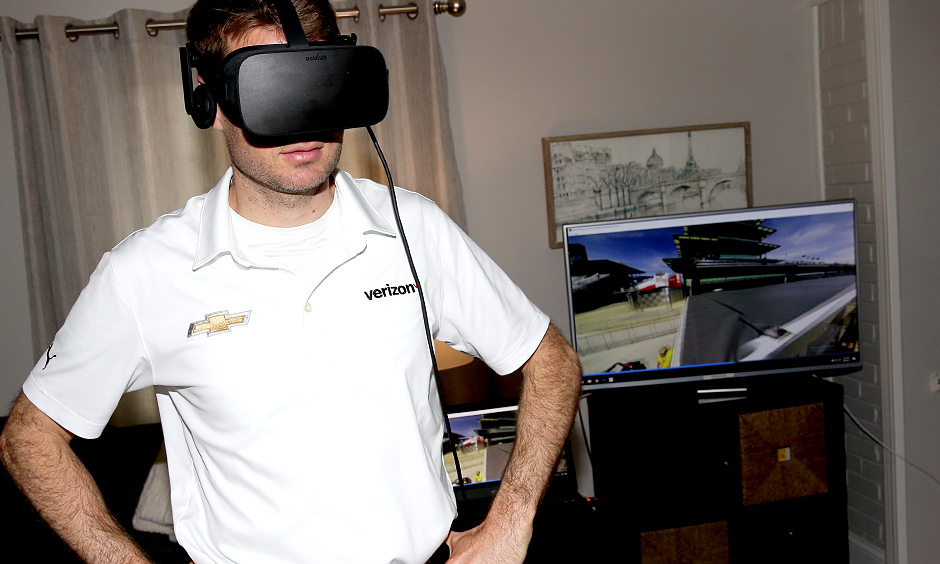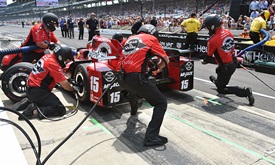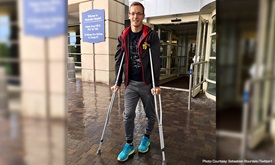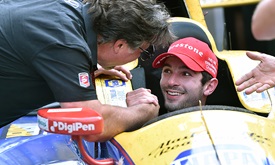Verizon testing '5G Home of the Future' in shadow of IMS
MAY 25, 2017
(This story originally appeared as exclusive content on the Verizon INDYCAR Mobile app. To download the app for use on smartphones, click here.)
SPEEDWAY, Indiana – From the outside, the house on Winton Avenue a few blocks from Indianapolis Motor Speedway looks like most other homes in its neighborhood. But inside is the gateway to the better things. It’s the Verizon and Ericsson “5G Home of the Future.”
Team Penske driver Will Power, whose car is sponsored by Verizon in the Verizon IndyCar Series, gave a tour of the 5G technology trial in the home. It’s the fifth generation of wireless technology and offers increased download and streaming speeds up to 100 times faster than existing networks. It’s all part of the Internet of Things (IOT) that focuses on the future, where everything from security cameras to ceiling fans will be connected and can be controlled wirelessly.
Verizon’s 5G technology is nearly four times faster than existing 4G LTE service – demonstrating the innovation, speed and connectivity of the new service. The 5G field test in this home coincides with Indianapolis 500 race weekend and is among those occurring in 11 U.S. test cities.
“It’s relatable to racing because we are always improving and trying to innovate and this is a huge step – 100 times faster with 5G is amazing,” Power said. “It’s always cool to be able to try the new things that Verizon is doing.
“We have live telemetry going around the track, so the speed of technology is very important to both INDYCAR and Verizon. When you think about the speed of the connection now versus when I just started, it’s night and day. That’s why it looks amazing.”
Power was also amazed to watch video of a Chevrolet Camaro equipped with 5G technology driving on the IMS road course with the windshield and windows covered so the driver had no visibility. He drove the course using virtual-reality goggles with the video transmitted in real time.
“They can put a camera on the car in real-time, black out the windows and a driver can drive the car with goggles,” said Power (shown above testing out the VR goggles). “INDYCAR has always been very forward thinking with the technology of the cars and Verizon’s partnership with the series is great for both.”
Power related what Verizon, Ericsson and Intel are doing with 5G technology to the progression of speed at Indianapolis Motor Speedway.
“Back at the first Indianapolis 500 in 1911 Ray Harroun won the race at an average speed of 74 miles per hour,” Power said. “This past weekend, Scott Dixon won the pole at over 232 miles per hour. That’s like how rapidly speed and performance has increased with Verizon leading the way.”
The increased speed from 5G allows seamless performance with virtual technology, evidenced by a 360-degree video camera that was placed atop a timing stand during Indianapolis 500 practice earlier this week at IMS. By wearing virtual-reality goggles, the user could scan the track as if there in person.
Also on display was an 8K television – more than double the performance and definition of the best 4K TVs currently on the market. The 5G technology will be crucial to 8K performance.
“You can get a full 360-degree view with the goggles and it makes you feel like you are there,” Power explained. “High-speed enhancements allow you to be there live and it feels like you are actually there, which is amazing. With the streaming video, you can be at a game or race sitting in the crowd live when you are just sitting at home. That’s pretty cool.
“The 8K TV is a lot denser and the picture is amazing. It’s great if you are a gamer.”
Verizon enhances network coverage at Indianapolis Motor Speedway
Verizon has also worked to improve performance and reliability for fans attending this weekend’s 101st Indianapolis 500 presented by PennGrade Motor Oil. Indiana’s first permanent installations of matsing ball technology has been deployed at IMS to enhance network coverage for wireless users this weekend. Built by hand and each installed with 36 to 60 antennas, the large spheres that can weigh more than 600 pounds have been installed at four locations on the IMS grounds.
Dan Huffman, Verizon principal engineer, said the updates represent the largest installation of matsing ball technology in the United States.
“The extreme focus provided by this technology will make this fan experience one of the best in the nation at a sports venue,” Huffman said.
In the Turn 3 area of IMS alone, Verizon has increased coverage by 333 percent and capacity by 200 percent with the new technology. It means race fans will be able to send texts, emails, video and photos more quickly than in the past. Verizon is the only carrier with permanent network infrastructure installed at the track.
The new technology can significantly increase capacity at events such as the Indy 500, where large concentrations of people are simultaneously using mobile devices. At last year’s race, fans shattered records using a total of 20.8 terabytes of data on the Verizon network – more than double what was used in 2015. One terabyte of data is equivalent to streaming roughly 1,000 hours of online video content.





















